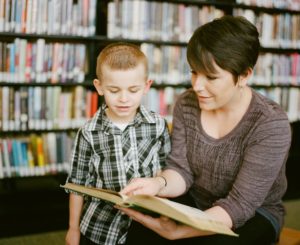Funktionen von Kommunikation
Es können unterschiedliche Absichten der Beteiligten zur Kommunikation führen.

Diese Funktionen von Kommunikation werden von Kindern in der gemeinsamen (natürlichen) Interaktion mit Erwachsenen erlernt.
 Literatur
Literatur
- Castañeda, Claudio; Hallbauer, Angela (2013): Einander verstehen lernen – Ein Praxisbuch für Menschen mit und ohne Autismus. Kiel: Holtenauer Verlag.
- Delhees, Karl (1994): Soziale Kommunikation. Opladen: Westdt. Verlag.
- Röhner, Jessica; Schütz, Angela (2020): Psychologie der Kommunikation. Berlin u.a.: Springer.
- Weinert, Sabine; Grimm, Hannelore (2012): Sprachentwicklung. In: Scheider, Wolfgang; Lindenberg, Ulmen (Hrsg.): Entwicklungspsychologie. Göttingen: Hogrefe, S. 433-456.
Zugrundeliegendes Verständnis von Kommunikation
Vorheriges
Bedeutung von Kommunikation
Nächstes
-
Einführung 2
-
Herzlich willkommenLecture1.1
-
SelbstreflexionLecture1.2
-
-
Personenkreis Menschen mit Autismus-Spektrum-Störung 6
-
Personenkreis Menschen mit Autismus-Spektrum-StörungLecture2.1
-
Diagnostische Merkmale einer Autismus-Spektrum-StörungLecture2.2
-
Besonderheiten im VerhaltenLecture2.3
-
Besonderheiten in der Kommunikation – AllgemeinesLecture2.4
-
Besonderheiten in der Kommunikation – Joint AttentionLecture2.5
-
Besonderheiten in der Kommunikation – Zentrale KohärenzLecture2.6
-
-
Kommunikation 8
-
KommunikationLecture3.1
-
Was ist Kommunikation?Lecture3.2
-
Begriffsbestimmung “Kommunikation”Lecture3.3
-
Menschliches Grundbedürfnis nach KommunikationLecture3.4
-
Kommunikationstheorien und -modelleLecture3.5
-
Zugrundeliegendes Verständnis von KommunikationLecture3.6
-
Funktionen von KommunikationLecture3.7
-
Bedeutung von KommunikationLecture3.8
-
-
Unterstützte Kommunikation 6
-
Kommunikative Erfahrungen von Menschen mit kommunikativen Auffälligkeiten und eingeschränkter LautspracheLecture4.1
-
Anknüpfungspunkt der Unterstützten KommunikationLecture4.2
-
Was ist Unterstützte Kommunikation?Lecture4.3
-
Förderung der Kommunikativen KompetenzLecture4.4
-
Welche Kommunikationsformen gibt es?Lecture4.5
-
Zugang zu Unterstützter KommunikationLecture4.6
-
-
Unterstützte Kommunikation und Diagnostik 5
-
Herausforderungen bei der DiagnostikLecture5.1
-
Vorgehen bei der DiagnostikLecture5.2
-
Das Gespräch/Die BefragungLecture5.3
-
Die BeobachtungLecture5.4
-
Diagnostische TestverfahrenLecture5.5
-
-
Kommunikationsförderung 8
-
KommunikationsförderungLecture6.1
-
Kommunikationsförderung bei Menschen mit ASSLecture6.2
-
IntentionalitätLecture6.3
-
Intentionalität in der UKLecture6.4
-
Bedeutung der Intentionalität für UKLecture6.5
-
Intentionalität herstellenLecture6.6
-
Etablierung eines ZeichensLecture6.7
-
Intentionalität bei Menschen mit ASSLecture6.8
-
-
Modelling als Ansatz der Kommunikationsförderung 12
-
Modelling als Ansatz der KommunikationsförderungLecture7.1
-
Modelling in der Unterstützen Kommunikation – EinführungLecture7.2
-
Lernen am Modell bei regulärer SprachentwicklungLecture7.3
-
Spracherwerb bei (noch) fehlender LautspracheLecture7.4
-
Modelling als Umdenken in der KommunikationsförderungLecture7.5
-
Prinzipien des ModellingLecture7.6
-
Die Umsetzung des Modelling im AlltagLecture7.7
-
Modelling, Vokabular & ThemenfelderLecture7.8
-
Auswahl der einzuführenden WörterLecture7.9
-
Modelling in der Umsetzung als FachkraftLecture7.10
-
Modelling Schritt für SchrittLecture7.11
-
Was Sie als Fachkraft mitbringen solltenLecture7.12
-
-
Beispielvideos Modelling 9
-
Modelling Beispielvideos EinführungLecture8.1
-
Modelling Video 1Lecture8.2
-
Modelling Video 2Lecture8.3
-
Modelling Video 3Lecture8.4
-
Modelling Video 4Lecture8.5
-
Modelling Video 5Lecture8.6
-
Modelling Video 6Lecture8.7
-
Gedankensammlung zu den VideosLecture8.8
-
Modelling bei Menschen mit Autismus-Spektrum-StörungenLecture8.9
-
-
Abschluss 3
-
Überprüfung der LernzieleLecture9.1
-
SchlusswortLecture9.2
-
RückmeldungLecture9.3
-




